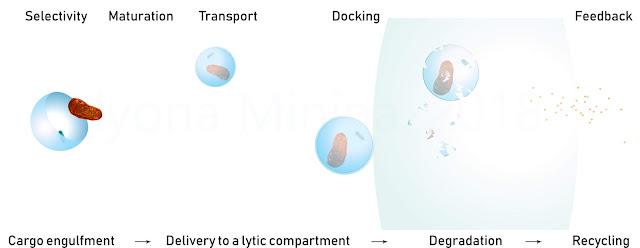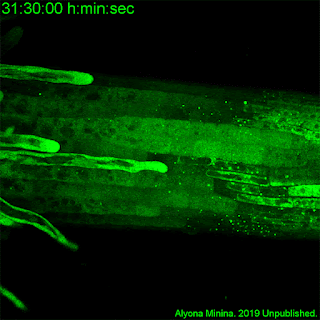Keywords: autophagy, plants, cell fate, cell maintenance, genetics, molecular biology, cell molecular biology, genetic engineering, advanced microscopy, je suis GMO
I am interested in the molecular clockwork underlying most basic cellular mechanisms: cell differentiation, maintenance and its programmed death. Luckily, instead of spreading thin, I can focus my research on autophagy, which is implicated in virtually all aspects of cellular life. To add even more to its value, autophagy is an extremely interesting example of a mechanism conserved among almost all eukaryotes1,2 and shaped to fit different life strategies.
Autophagy ensures sustainability of a eukaryotic cell. It recycles cellular content, keeping the cell functional and reducing its requirement for outsourced energy and nutrients. Upon activation of autophagy a fraction of cellular content is sequestered into a newly build double membrane vesicle, called autophagosome, and delivered to a lytic compartment for degradation. The products of degradation are then recycled by the cell3.
Autophagy can degrade individual molecules, complexes and even organelles. It is crucial for maintenance of long living cells in a functional shape and order, for removing unnecessary content during cell differentiation, for surviving starvation and other types of stresses. Despite the obvious importance of autophagy, surprisingly little is known about its mechanism in plants. I am interested in investigating molecular machinery of autophagy focusing on its plant-specific features.
|
| |
Autophagosome formation in epidermal root cells of Arabidopsis thaliana. Alyona Minina, 2019.
Leica TCS SP5 confocal. |
Dynamics of autophagy activity in Arabidopsis thaliana root. Light-Sheet microscopy,MuVi SPIM Luxendo |
What is the selectivity of plant autophagy under different stresses?
When autophagy is massively activated, it appears to degrade cytoplasmic content in “bulk”. It is not clear though, how a massive non-selective degradation of a cellular content might be helpful for survival under stress conditions. Emerging high-throughput studies performed on animal model systems indicate, that bulk autophagy is not that bulk after all4.
What are the mechanisms regulating maturation of plant autophagosomes?
To be able to successfully engulf a cargo the membrane of a forming autophagosome must elongate and close on itself forming an outer and an inner membrane layer of a mature structure. We know close to nothing about the mechanisms regulating maturation of autophagosomes in plants.
How are plant autophagosomes delivered to the lytic vacuole?
Mature autophagomes containing cargo should be transported from the site of their formation to a lytic compartment. It is not known yet, what is the mechanism of autophagosome trafficking in plants. Furthermore, some studies indicate, that alternatively autophagosome might be targeted to the secretion pathway to help cell "spit out" the cargo5.
How do plant autophagosomes recognize the membrane to fuse with?
The outer membrane of a mature autophagosome should fuse with the membrane of a lytic compartment and avoid fusion with other membranous structures present in the cell. The mechanisms regulating plant autophagosome docking/fusion to/with the lytic vacuole are unknown.
How are the products of degradation recycled by the cell?
Plant lytic vacuoles are filled with proteases, lipases and nucleases capable of digesting the cargo of autophagosomes into oligopeptides, nucleotides and fatty acids. Very little is known yet about the role of vacuolar permeases in plant autophagy.
Posted by Alyona Minina on the 2017.03.04. Last updated on the 2018.11.05



